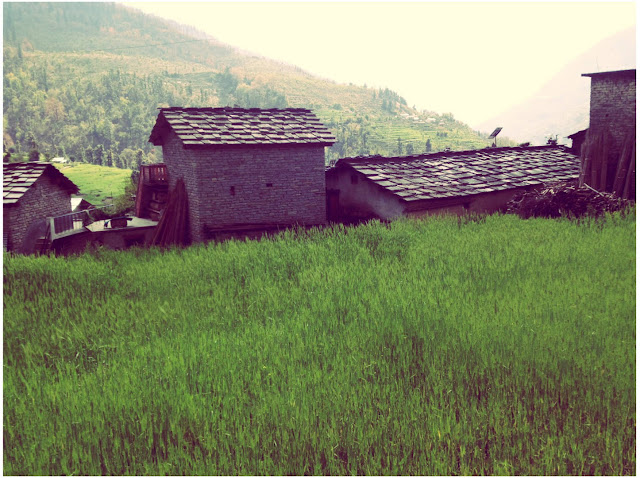by Elliott Ford, Deep Green Resistance UK
Whist traveling in the North Indian State of Uttrakhand, my beloved (Rachel) and I decided to visit a small village in the Himalayas called Khati, that had yet to receive a connection to the national electric grid. We hoped to get a brief insight into existence of a people that hadn’t become ‘developed’ and at the same time take in some beautiful views of the Himalayan range. I also thought this would be an appropriate time to start a book I’d been meaning to read called Ancient Futures by Helena Norberg-Hodge which describes the effects of ‘development’ of the Ladakhi people in the 1980’s.
We set off on an old Enfield motorcycle traveling North into the mountains until the road turned to a treacherous uphill track and then eventually stopped altogether. We left the bike by the house of a friendly local man and started the walk to Khati which would last three days and take us over passes of 3500m.
As we approached Khati and walked through terraced monocrops of wheat, we realised it was unlikely we would be visiting a village unaffected by globalisation. Growing a single crop usually indicates that a rural area has switched from being self sufficient to selling the produce of monocrops to earn money and buy the necessities of life, as well as alluring luxuries. Our suspicions were confirmed when we stopped in a local tea shop and were offered Coca-cola and a selection of packaged foods that were essentially refined wheat and sugar, processed and marketed in different ways. Continuing on our journey we noticed litter was increasingly present as we neared the village. Prior to development there would have been no litter as everything would have come from the local area and eventually returned to the cycle in a different form. Plastic is different, it has no cycle to return to, it remains as litter, is burnt (releasing lots of carcinogens) or is thrown into a river to be carried to the ocean.
Many empty alcohol bottles were amongst the litter indicating a high level of alcohol consumption, another consequence of ‘development’ said to be caused by increasingly stressful lifestyles and exposure to advertising. And it appeared that these people were consuming plenty of advertising because, as houses came into view, we could see that each had a small solar panel and satellite dish on the roof. This meant that each house had a TV, exposing its residents to all the material things they “need” to be happy, and making them firmly aware of how much they lack. Prior to having the lifestyles of people from faraway places transmitted into their homes, it is likely that people would have been more content with what they had.
As we walked though the village to a guesthouse we passed a group of uniformed children who were returning home from school. It seemed that the Western education system had been adopted meaning children no longer spent their days learning knowledge and wisdom from their elders about local traditions and how to live on the land. Instead, children would compete with each other to learn abstract knowledge, chosen by people that had never set foot in their village. The result would be young people who lack skills to live on the land and instead have a skill set designed to serve the global economic system that will often involve them leaving the community for an urban centre.
It’s not just lack of appropriate skills that motivates young people to leave their community, as through exposure to T.V and tourists, young people reject their own culture, which is now viewed as inferior or backward, and strive to adopt the new Western culture and image. Teenagers we passed later were dressed in a way that meant they wouldn’t have looked out of place in any European city. Older generations still dressed in a more traditional way, wearing locally woven fabrics suggesting that the development process started relatively recently.
We stayed the night in the village and left the next day feeling sad, but not surprised, that the Western civilisation, based on endless expansion, had grown to envelop such a remote place. Norberg-Hodge describes the process of being enveloped as a “systemic transformation of society”, including many of the recent changes we’d observed in Khati.
I later reflected on what would cause the people of Khati to sacrifice their independence and rich, complex way of life to strive for ‘development’ where they’d become servile in a system of billions of people, with little chance of success, having their lives determined by activities and decisions made in distant places. Norberg-Hodge claims that looking at the modern world from the perspective of undeveloped people, “our culture looks infinitely more successful from the outside than we experience it on the inside.” In other words, it is a carefully crafted illusion that lures communities into an inescapable grasp before they realise the fallacy. Or maybe, like the majority of people in the West, they won’t realise the fallacy and instead continually strive for something that is just beyond their reach.
In the past, communities would be violently coerced to adopt ways of living for the benefit of ruling groups. “Today’s conquistadors are development, advertising, the media, and tourism.” Norberg-Hodge states, a process considerably more insidious than previous techniques and as a tourist one I must accept my part in. Although tourism to Khati is small compared to Ladakh, our presence would have far-reaching and unknown consequences.
My lasting impression was that if Western civilisation stopped tomorrow, after an initial period of readjustment, the people of Khati would experience a considerable improvement in their lives. Generations of people are still alive that possess knowledge that the younger generations seem unable and uninterested to receive. But those elders won’t be alive for much longer. Western civilisation must be stopped as soon as possible.
